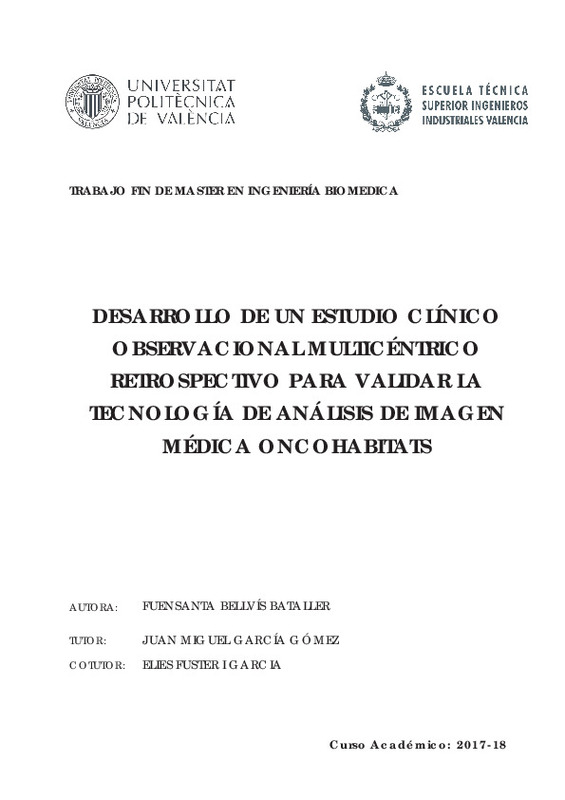|
Resumen:
|
[ES] El Glioblastoma es uno de los tumores primarios del sistema nervioso central más frecuente en adultos con una supervivencia media de 15 meses. Desde la publicación del tratamiento Stupp estándar en el año 2005, ninguna ...[+]
[ES] El Glioblastoma es uno de los tumores primarios del sistema nervioso central más frecuente en adultos con una supervivencia media de 15 meses. Desde la publicación del tratamiento Stupp estándar en el año 2005, ninguna terapia ha demostrado una mejora significativa en la supervivencia global de los pacientes que lo sufren. Uno de los factores responsables de su alta agresividad y resistencia contra las terapias existentes, es su heterogeneidad intra- e inter-paciente. Esta situación pone de manifiesto la necesidad de crear tecnologías que de forma no invasiva y precisa sean capaces de crear subgrupos de pacientes con una baja heterogeneidad, permitiendo la creación de terapias mucho más dirigidas.
La tecnología de análisis de imagen médica OncoHabitats define unas regiones de interés y marcadores asociados dentro de las zonas de tumor activo y de edema, en función de la información hemodinámica obtenida a partir de las secuencias de perfusión de los estudios de imágenes de resonancia magnética. En las pruebas de concepto realizadas se ha obtenido una correlación significativa entre estos marcadores y la supervivencia global del paciente. Sin embargo, para establecerse como un biomarcador pronóstico se debe de crear un estudio que englobe una mayor cantidad de pacientes y de centros. Por esta razón, se ha desarrollado un estudio multicéntrico e internacional de tipo observacional y retrospectivo, en el cual han participado 7 hospitales pertenecientes a 4 países diferentes, reclutando un total de 305 pacientes. En el presente trabajo se han desarrollado todas las fases del estudio, excepto la obtención de los resultados estadísticos definitivos. Se ha comprobado que los resultados preliminares se mantienen en línea con los hallazgos de los estudios piloto.
La validación de OncoHabitats como biomarcador pronóstico permitirá su uso como herramienta de decisión en el seguimiento de pacientes con Glioblastoma.
[-]
[EN] Glioblastoma is one of the most common primary tumours of the central nervous system in adults with an average survival of 15 months. Since the publication of the standard Stupp treatment in 2005, no therapy has shown ...[+]
[EN] Glioblastoma is one of the most common primary tumours of the central nervous system in adults with an average survival of 15 months. Since the publication of the standard Stupp treatment in 2005, no therapy has shown a significant improvement in the overall survival of patients suffering from it. One of the factors responsible for its high aggressiveness and resistance against existing therapies is its intra- and inter-patient heterogeneity. This situation highlights the need to create technologies that are non-invasively and precisely capable of creating subgroups of patients with low heterogeneity, allowing the creation of much more targeted therapies.
The OncoHabitats medical image analysis technology defines regions of interest and associated markers within the active tumor and edema zones, based on hemodynamic information obtained from the perfusion sequences of magnetic resonance imaging studies. In the proofs of concept carried out, a significant correlation has been obtained between these markers and the overall survival of the patient. However, in order to establish itself as a prognostic biomarker, it is necessary to create a study that includes a larger number of patients and centres. For this reason, a multicenter, international observational and retrospective study has been developed in which 7 hospitals from 4 different countries participated, recruiting a total of 305 patients. In the present work, all phases of the study have been developed, except the obtaining of the definitive statistical results. It has been proven that the preliminary results are in line with the findings of the pilot studies.
The validation of OncoHabitats as a prognostic biomarker will allow its use as a decision tool in the follow-up of patients with Glioblastoma.
[-]
|







